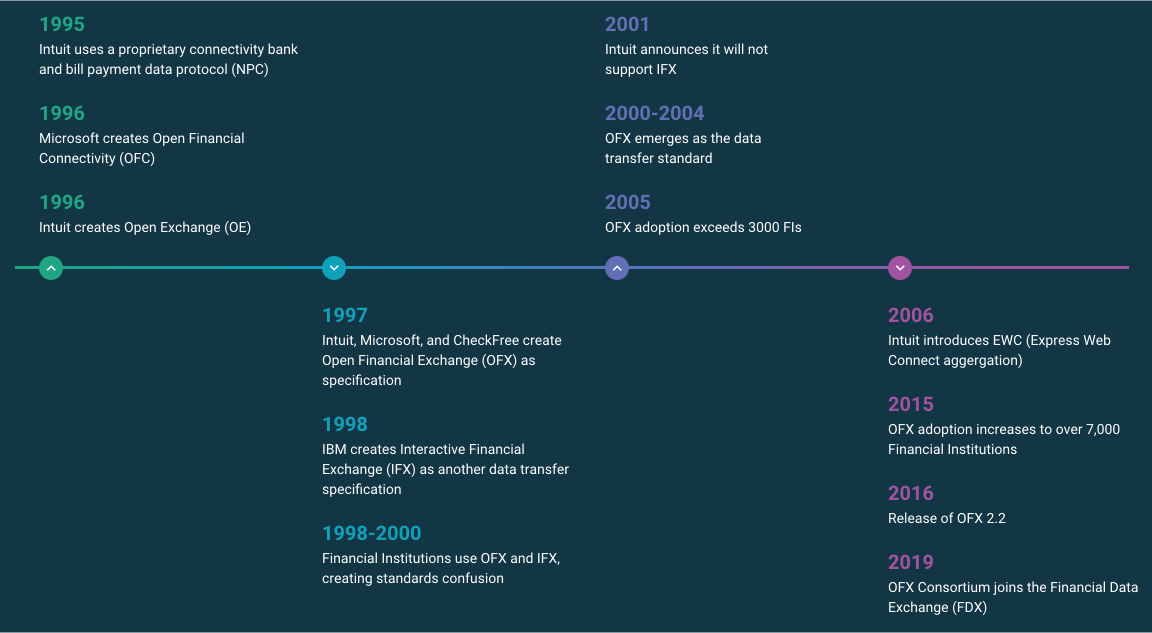Open Financial Exchange
| Filename extension |
.ofx |
|---|---|
| Developed by | Microsoft, Intuit and CheckFree |
| Initial release | February 14, 1997[1] |
| Latest release | 2.3[2] |
| Container for | Financial information |
| Extended from | SGML, XML, OFC |
| Extended to | QFX |
Open Financial Exchange (OFX) is a data-stream format for exchanging financial information that evolved from Microsoft's Open Financial Connectivity (OFC) and Intuit's Open Exchange file formats.[3]
History
Microsoft, Intuit and CheckFree announced the OFX standard on 16 January 1997. The first OFX specification, version 1.0, was released on 14 February 1997.[3] The specification allows for bank- and application-specific extensions, although only a subset is necessary to describe a financial transaction. Versions 1.0 through 1.6 relied on SGML for data exchange, but later versions are XML based. According to the main OFX site, "The specification is freely licensed, allowing any software developer to design an interface that will be supported on the front-end."[citation needed] In 2019, OFX's consortium joined Financial Data Exchange (FDX) consortium,[4][5] that manage nowadays OFX working group.[5]
Specification
The latest reference document (Functional Specification) describing the standard was published in October 2020, in version 2.3, by the FDX consortium's OFX working group.[6]
Support in various countries
Many banks in the US let customers use personal financial management software to automatically download their bank statements in OFX format, but most Canadian,[7][8][9] United Kingdom and Australian banks do not allow this, however, many banks do support downloading financial data in OFX, QFX, QIF, or spreadsheet format via their web interface for later import into financial software.
Intuit and QFX
QFX is a proprietary variant of OFX used in Intuit's products. In Intuit products, OFX is used for Direct Connect and QFX for Web Connect. Direct Connect allows personal financial management software to connect directly to a bank OFX server, whereas in Web Connect, the user needs to log in and manually download a .qfx file and import it into Quicken.[10]
See also
References
- ↑ "Open Financial Exchange FAQ". Retrieved October 22, 2020.
- ↑ "OFX.net". [dead link]
- ↑ 3.0 3.1 "OFX Work Group - FAQ's". Financial Data Exchange. Retrieved 2023-03-13.
- ↑
 [bare URL image file]
[bare URL image file]
- ↑ 5.0 5.1 https://financialdataexchange.org/FDX/About/About-FDX.aspx?WebsiteKey=deae9d6d-1a7a-457b-a678-8a5517f8a474&hkey=dffb9a93-fc7d-4f65-840c-f2cfbe7fe8a6&a315d1c24e44=5#a315d1c24e44 [bare URL]
- ↑ https://financialdataexchange.org/common/Uploaded%20files/OFX%20files/OFX%20Banking%20Specification%20v2.3.pdf [bare URL PDF]
- ↑ Reiser, David (11 March 2009). "Re: ofx info for scotiabank in canada?". gnucash-user (Mailing list). Retrieved 16 January 2012.
It appears the bank regulators have struck. http://faq.quickensoftware.ca/detail.php?buid=QK&qbid=QK1054 indicates that Online Banking Booster (the Intuit name for DirectConnect in Canada) was discontinued for all Canadian banks at the end of October 2008. The banks have apparently all added additional security questions at login that Quicken can't handle, so Intuit just bailed. In the US, Intuit has pushed the use of an additional token (CLIENTUID) as suitable for satisfying regulator's insistence on multifactor authentication. It remains to be seen how well that rolls out.
{{cite mailing list}}: External link in|quote= - ↑ "Online Banking Booster (OLBB) was discontinued on October 31, 2008. How does this affect me?". Quicken Support. Intuit Canada. 27 May 2011. Retrieved 16 January 2012.
- ↑ Selhi, Bylo (18 December 2007). "Re: Alternatives to Quicken". Financial Wisdom Forum » Under the Mattress: Protecting Your Money. Post 227689. Retrieved 9 January 2017.
- ↑ "Connectivity Types - OFX". Intuit. Retrieved 12 March 2023.